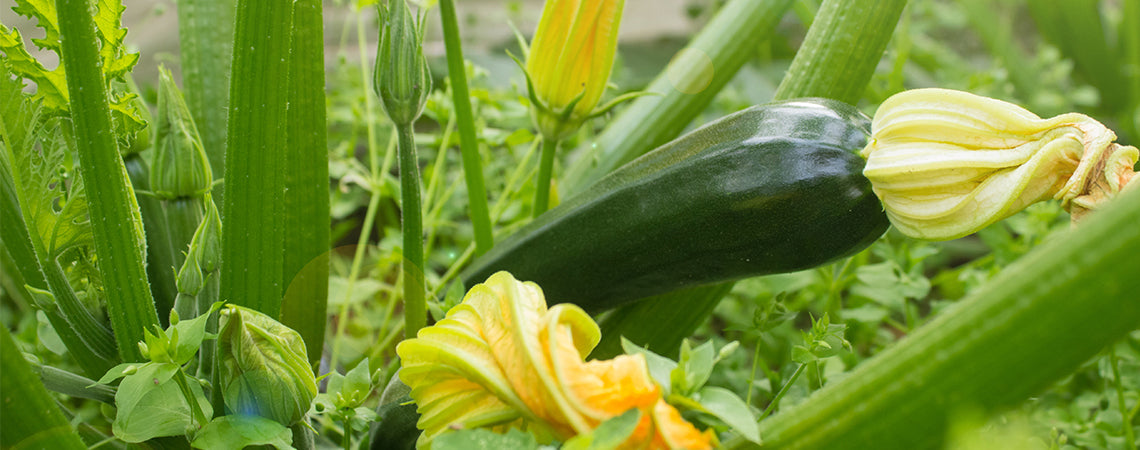How to Care for Zucchini Plants and Other Summer Squashes

Zucchinis and summer squashes are hearty, nutritious, and versatile vegetables. They make fabulous additions to soups, roasted kabobs, and pasta—you can even turn them into low-carb noodles with a spiralizer! Learning how to grow and care for zucchinis and summer squashes is always a worthwhile undertaking. Here’s how to grow them successfully in California.
Grow these nutritious summer squashes for use in all sorts of different dishes. You and your friends can enjoy them at all the summer dinners and barbecues you’ve got lined up!
When and Where to Plant Your Zucchinis
Our growing season for zucchinis is pretty long—you can sow their seeds anytime between April and mid-August. Succession planting throughout these months can create a continual harvest. Like most veggie plants, zucchinis and summer squashes need lots of sunshine, so plant them somewhere that gets 6–8 hours of direct sun every day.
There are three ways you can grow your zucchini plants:
- Let the plants sprawl outward on the ground
- Plant four seeds on top of a mound of soil
- Grow your zucchinis vertically with a tomato cage, trellis, or obelisk
If you decide to let the plants sprawl, you should space your seeds 3 feet apart, in rows that are about 3 feet apart. Zucchinis and squashes grown on a mound have higher chances of getting pollinated by bees or other pollinators. Growing squashes vertically is great if you don’t have a ton of room—you can space your seeds out 2 feet apart.

Watering Zucchinis
Summer squash prefers consistently moist soil but not soggy. One inch of water per week should suffice, but water more often if the weather is particularly hot and dry. Well-draining soil is a must—if it water pools and remains stagnant around the roots, they will start to rot. Avoid letting your soil dry out; this can increase the risk of blossom end rot. Applying a layer of mulch around the plants will help to slow the evaporation of moisture. Apply garden soil amendment like an organic vegetable fertilizer once per month to the soil around the plants.
When to Harvest
Once your zucchinis are 6–8 inches in length, that’s when they’ll have the tastiest flavor. If you like, you can grow them longer, and they can get as big as a watermelon, but they might taste bitter. They should be firm—softness is a sign of rot. Use a clean pair of shears to snip the fruit off the stem—don’t try to pull it off by hand, or you’ll risk damaging it.

Zucchini Growing Problems
Pest control can be an issue— Other insects may munch on your vines, so if you see any pest damage, we recommend using an organic insecticidal soap or neem oil spray to eliminate them naturally.
Mildew can be an issue with squash foliage. Adequately spacing your seeds should help prevent mildew by allowing more air circulation. If you see a powdery coating on the leaves, remove any heavily damaged leaves and apply a copper-based fungicide.
If your plant produces flowers but no fruits, or if the fruits come out stumpy and shriveled, that’s a sign that pollination isn’t occurring. Planting lots of native flowers around your veggie garden will help to attract more pollinators, but you can also pollinate by hand with a paintbrush. All squash are monoecious, meaning that they have separate male and female flowers on the same plant. Male flowers appear first after planting, but won’t turn into fruit. The female flowers, which show up 10-14 days later, will turn into zucchinis after pollination.

How to Dispose of Your Zucchini Plants at the End of the Season
You’ll be pulling up a great deal of foliage at the end of the gardening season. The best thing you can do is toss the remains in the compost bin, provided they show no signs of fungal damage. This way, you can use it to feed the next season’s batch of garden veggies!
On the hunt for starter plants or seeds to grow zucchinis in California? Visit Roger’s Gardens—we have plenty of different varieties of these and other summer squashes with delicious fruits of different flavors, sizes, shapes, and colors. Discover your new favorite variety today!
For more information, view: How to Plant & Maintain Strawberries, Peppers, Beans, & Squash